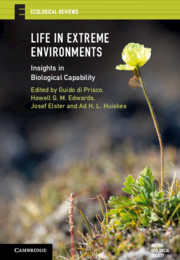Book contents
- Life in Extreme Environments
- Ecological Reviews
- Life in Extreme Environments
- Copyright page
- Dedication
- Contents
- Contributors
- Introduction
- Part I Extreme environments: responses and adaptation to change
- Part II Biodiversity, bioenergetic processes, and biotic and abiotic interactions
- Chapter Four Metazoan life in anoxic marine sediments
- Chapter Five How to survive winter?
- Chapter Six Vertebrate viruses in polar ecosystems
- Part III Life in extreme environments and the responses to change: the example of polar environments
- Part IV Life and habitability
- Index
- Plate Section (PDF Only)
- References
Chapter Five - How to survive winter?
Adaptation and acclimation strategies of eukaryotic algae from polar terrestrial ecosystems
from Part II - Biodiversity, bioenergetic processes, and biotic and abiotic interactions
Published online by Cambridge University Press: 28 September 2020
- Life in Extreme Environments
- Ecological Reviews
- Life in Extreme Environments
- Copyright page
- Dedication
- Contents
- Contributors
- Introduction
- Part I Extreme environments: responses and adaptation to change
- Part II Biodiversity, bioenergetic processes, and biotic and abiotic interactions
- Chapter Four Metazoan life in anoxic marine sediments
- Chapter Five How to survive winter?
- Chapter Six Vertebrate viruses in polar ecosystems
- Part III Life in extreme environments and the responses to change: the example of polar environments
- Part IV Life and habitability
- Index
- Plate Section (PDF Only)
- References
Summary
The polar regions are of outstanding international scientific and environmental significance as they support important components of the global biogeochemical cycles. They comprise a whole range of habitats with extreme environmental conditions, which challenge living organisms with multiple environmental stresses. At the same time, they are vulnerable to disturbances and have long recovery times
- Type
- Chapter
- Information
- Life in Extreme EnvironmentsInsights in Biological Capability, pp. 101 - 125Publisher: Cambridge University PressPrint publication year: 2020
References
- 1
- Cited by

